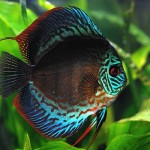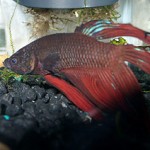Introduction
If you want to start breeding fish, you need to identify the difference between the mommy fish and the daddy fish. For some fish species, dimorphic, identifying who is the mommy and daddy is easy, but for other species, isomorphic, it becomes much more difficult.
Dimorphic
Dimorphic fish allows you to identify the difference between the male and female of the species in two or more ways. The males will usually be brighter in color, have a larger body and larger fins. Of course the opposite is true for the females. They are smaller and have dimmer colors.
My Tiger Barbs are considered dimorphic. This is because the males have several differences between them and the female Tiger Barb. For example, the male has a bright red nose and mouth, with bright red vertical fins and a red stripe above the black on the dorsal fin.
The females have a pale red nose and mouth, dull vertical fins and a dull red stripe above the black on the dorsal fin.
With this description, of my seven Tiger Barbs, I have two males and five females.
Isomorphic
Isomorphic fish species presents a challenge to the Aquarist. There is probably only one way you can tell the difference between the mommy and daddy fish.
For example, my Blue Three Spot Gourami are considered to be isomorphic. The single way I can use to tell the difference between the sexes is that the male’s dorsal fin comes to a distinct point. The female’s dorsal fin is rounded.
Using this as a guide I have one male and three females.
My three Kissing Gourami are a different story. The only guidance I have is to look at the size. The females are much more rounded than the males.
Based on this I think I have two females and one male, I think.
The Only Proven Way
Dimorphic fish are easy to breed because you can be 90% confident that you have selected two of different sexes. But with isomorphic fish it is a toss-up.
The only sure way to know if you can breed two fish is to put two in a breeder tank. If nothing happens after about a week, you probably have two of the same-sex. If this happens to you it is time to swap one fish out with another one of the same species.
Conclusion
Determining the mommy and daddy fish who are dimorphic is easy. But you will have more of a challenge if you have a species that is considered isomorphic.

















Leave a Reply